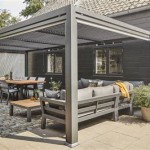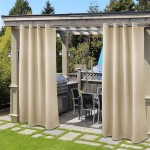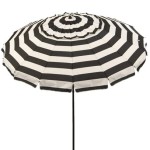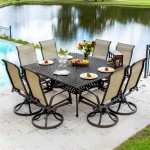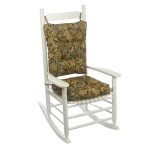Best Outdoor Rugs For An Uncovered Patio
Selecting the right outdoor rug for an uncovered patio requires careful consideration. The rug must withstand the elements, maintain its aesthetic appeal, and provide comfort underfoot. This article explores the key factors involved in choosing an outdoor rug for an uncovered patio and highlights some of the best materials and styles available.
Understanding the Challenges of An Uncovered Patio
Uncovered patios are exposed to a wide range of weather conditions, including direct sunlight, rain, wind, and temperature fluctuations. These elements pose several challenges for outdoor rugs. Prolonged exposure to sunlight can cause colors to fade and materials to degrade. Rain and moisture can lead to mold and mildew growth, especially if the rug doesn't dry quickly. Wind can lift and displace lightweight rugs, and fluctuating temperatures can cause materials to expand and contract, potentially leading to damage.
Therefore, the ideal outdoor rug for an uncovered patio must be durable, water-resistant, UV-resistant, and relatively heavy or secured to prevent movement. It should also be easy to clean and maintain to prevent the buildup of dirt, debris, and mold.
Key Materials For Outdoor Rugs In Exposed Environments
The material of an outdoor rug significantly impacts its performance and longevity in an uncovered patio. Several materials are well-suited for this purpose, each with its own advantages and disadvantages.
Polypropylene: Polypropylene, also known as Olefin, is a synthetic fiber that is highly resistant to water, stains, and fading. It is a popular choice for outdoor rugs because it dries quickly and is relatively inexpensive. Polypropylene rugs are often used in high-traffic areas and are easy to clean with soap and water. However, polypropylene is not as heat-resistant as some other materials and can melt if exposed to high temperatures.
Polyester: Polyester is another synthetic fiber that is commonly used in outdoor rugs. It is similar to polypropylene in terms of water resistance and durability, but it is often softer and more comfortable underfoot. Polyester rugs are also generally more fade-resistant than polypropylene rugs. Like polypropylene, polyester is relatively inexpensive and easy to clean. However, it is also susceptible to melting at high temperatures.
Nylon: Nylon is a highly durable synthetic fiber that is resistant to wear and tear. It is often used in high-end outdoor rugs because of its exceptional strength and resilience. Nylon rugs are also stain-resistant and easy to clean. However, nylon is more expensive than polypropylene and polyester, and it is not as resistant to fading as some other materials. UV-treated nylon is a must for uncovered patios. The initial cost is higher, but the lifespan of the rug is extended considerably.
Acrylic: Acrylic fibers are similar to wool in texture and appearance, making them a good choice for those who want a more natural look in an outdoor rug. Acrylic rugs are water-resistant, fade-resistant, and easy to clean. They are also relatively soft and comfortable underfoot. However, acrylic is not as durable as polypropylene, polyester, or nylon, and it can be more susceptible to pilling.
Jute and Sisal (Treated): Jute and sisal are natural fibers that are traditionally used for indoor rugs. However, specially treated versions can be used outdoors, although their lifespan will be shorter than synthetic options, especially in uncovered environments. These rugs offer a natural, textured look and feel. To be suitable for outdoor use, jute and sisal rugs must be treated with a water-resistant coating and should ideally be placed in a covered area where they are protected from direct rain and sunlight. Without proper treatment, these materials can quickly degrade when exposed to moisture and UV rays.
Recycled Materials: Many outdoor rugs are now made from recycled materials, such as plastic bottles or tires. These rugs are a sustainable option that can be just as durable and water-resistant as rugs made from virgin synthetic fibers. Rugs made from recycled materials are often available in a wide range of colors and styles, making it easy to find one that matches your patio decor.
Factors To Consider: Construction, Style, and Additional Features
Beyond the material, the construction and style of an outdoor rug also play a crucial role in its suitability for an uncovered patio.
Construction: Outdoor rugs are typically constructed using one of three methods: woven, tufted, or hooked. Woven rugs are the most durable and are less likely to shed or unravel. Tufted rugs are less expensive than woven rugs but may be more prone to shedding. Hooked rugs have a looped pile that can be comfortable underfoot but may also be more susceptible to snagging. For an uncovered patio, a tightly woven rug is generally the best choice, as it will be more resistant to wear and tear from the elements.
Style and Design: Outdoor rugs are available in a wide range of styles and designs, from traditional patterns to modern geometric prints. The style of rug you choose should complement your existing patio furniture and decor. Consider the color scheme of your patio and select a rug that will either blend in or provide a pop of color. Darker colors tend to hide dirt and stains better than lighter colors.
Size and Shape: The size and shape of your outdoor rug should be appropriate for the size and layout of your patio. A rug that is too small will look out of place, while a rug that is too large may overwhelm the space. Consider the placement of your patio furniture when selecting a rug size. A rug can be used to define a seating area or to anchor a dining table. Common shapes for outdoor rugs include rectangles, squares, circles, and ovals.
UV Resistance: Exposure to sunlight is a significant concern for uncovered patios. Look for rugs that are specifically labeled as UV-resistant or fade-resistant. These rugs have been treated to withstand the damaging effects of the sun and will maintain their color and appearance for longer. Rugs made from solution-dyed fibers are particularly resistant to fading.
Water Resistance and Drainage: Water resistance is crucial for preventing mold and mildew growth. Look for rugs that are made from water-resistant materials and that have a backing that allows water to drain through. Some outdoor rugs also have antimicrobial properties that help to inhibit the growth of mold and bacteria.
Ease of Cleaning: Outdoor rugs are bound to get dirty, so it's important to choose one that is easy to clean. Most outdoor rugs can be cleaned with soap and water or with a garden hose. Some rugs can even be machine-washed. Consider your cleaning preferences when selecting an outdoor rug. Regular cleaning will help to keep your rug looking its best and will also prevent the buildup of dirt and allergens.
Weight and Security: Lightweight rugs are easily blown around by the wind, especially in an uncovered patio. Choose a rug that is heavy enough to stay in place, or consider using rug grippers or outdoor tape to secure the rug to the patio surface. Rug pads can also help to prevent the rug from slipping and sliding. For particularly windy areas, consider rugs with a rubber backing that will grip the patio surface.
Maintenance and Care For Longevity
Even the most durable outdoor rug requires regular maintenance to prolong its lifespan and maintain its appearance. Here are some tips for caring for your outdoor rug:
Regular Cleaning: Sweep or vacuum your outdoor rug regularly to remove dirt, leaves, and other debris. This will prevent the buildup of dirt and stains. For deeper cleaning, use a garden hose to rinse the rug. You can also use a mild detergent and a scrub brush to remove stubborn stains. Always allow the rug to dry completely before placing furniture back on top of it.
Spot Cleaning: Address spills and stains immediately to prevent them from setting. Blot the spill with a clean cloth or paper towel. Avoid rubbing, as this can spread the stain. For stubborn stains, use a stain remover specifically designed for outdoor rugs.
Mold and Mildew Prevention: If your outdoor rug gets wet, be sure to dry it thoroughly to prevent mold and mildew growth. You can hang the rug up to dry or lay it flat in the sun. If you live in a humid climate, consider using a dehumidifier to help keep your rug dry.
Winter Storage: In areas with harsh winters, it is best to store your outdoor rug indoors during the off-season. Clean the rug thoroughly before storing it and make sure it is completely dry. Store the rug in a dry, well-ventilated area.
Choosing the right outdoor rug for an uncovered patio demands careful consideration of material, construction, style, and maintenance. By prioritizing durability, water resistance, UV protection, and ease of cleaning, you can select a rug that not only enhances the aesthetic appeal of your patio but also withstands the challenges of an outdoor environment.

Unique Loom Soft Border Outdoor Area Rug 8 X 11 4 Brown

49 Best Outdoor Rugs 2025 For Patios Hgtv

Livabliss Bodrum Modern Indoor Outdoor Area Rug 7 10 X Dark Blue
Ravenna Indoor Outdoor Rug Pierce Costco

49 Best Outdoor Rugs 2025 For Patios Hgtv

Everything You Need To Know About Outdoor Rugs Boutique

Unique Loom Outdoor Safari Collection Area Rug Leopard 3 X 5 1 Rectangle Blue Yellow

Ultimate Outdoor Rug Buying Guide For Your Patio World Market

Outdoor Rugs That Can Survive In The Rain Rug District

Types Of Outdoor Rugs The Home

